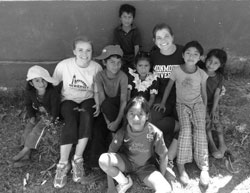While some students from New Jersey planned on spending their spring breaks catching up on sleep at home or partying on the beaches of Cancun, others spent their breaks making a difference in a community or foreign country.
Many colleges around the country are now offering alternative spring break trips. These trips are created for students who are interested in spending their week off helping others in their communities or in other parts of the world. Students who are interested can plan a trip through their school or through an organization, such as Habitat for Humanity.
Since Super Storm Sandy hit New Jersey, some schools have decided to create alternative spring break projects here at the Jersey Shore. Max Dolphin, Drew University student, spent his spring break not too far from his home in Seaside Heights. Dolphin said that coming home to devastation is humbling. “To see the devastation firsthand in my hometown and surrounding area is an experience that really leaves you shell-shocked,” said Dolphin.
A group of students from Drew University had difficulty trying to find a place to sleep during their service project because hotels and homes around Seaside Heights are still damaged from the storm. For example, in Seaside Heights, the destruction of Hurricane Sandy is still present in every direction. “When I first saw the image of the roller coaster and missing pier I was left in shock and awe,” said Dolphin. The roller coaster was recently dismantled and Seaside Heights is beginning the restoration process across town.
Dolphin mentioned that he worked with a non-profit organization, Community Collaboration International (CCI). According to the CCI website, the organization specializes in disaster relief efforts within the United States, along with ecological and environment-related projects across three other continents. They are also currently running alternative spring break trips to Louisiana to help with Hurricane Isaac relief.
Even though the Jersey Shore is a “hot spot” for alternative spring breakers this year, other spots across the country are also attracting students. Dan Suskevich, Villanova University student, traveled to Athens, Georgia during his spring break.
Suskevich helped out at the Oasis Católico San Rafael, located in the outskirts of Athens. Suskevich explains the location as a convent that is run by nuns for undocumented immigrants. Suskevich worked on many projects there, from tutoring third graders to doing home repairs.
The most significant part for Suskevich was interacting with the third graders. Suskevich explained that he learned about their living conditions while reading an Arthur book to the children. According to Suskevich, one character in the book had many possessions, such as her own hair dryer, TV, and bed.
In addition to tutoring children, Suskevich also ripped out floors in some trailers that surround the convent. He said that the living conditions were terrible because there were five people living in a bedroom meant for one. “It was an eye-opening experience,” said Suskevich. “You start to realize everything that you have that’s great, and realize that you can’t take it for granted.”
Here at the University, the Residence Hall Association (RHA) planned an alternative spring break trip to Guatemala for the third consecutive year.
For some students, this was their first major service trip. Danielle St. Vincent, University student, was excited to go to Guatemala this past spring break. Students built classrooms in Chichicastenango, a small mountain town two hours northwest of Guatemala City.
St. Vincent said that the biggest challenge on this trip was communicating with locals. “Where we [went] in Guatemala, [the locals] speak K’iche’,” she said. “Some people down there don’t even understand Spanish.” In addition to the language barrier, she also said that the water in Guatemala is not safe due to cholera, therefore only bottled water can be consumed.
Another difference between this trip and domestic trips are the precautions that need to be taken before traveling. St. Vincent said that she needed to get shots for tetanus, hepatitis A, and typhoid. The Center for Disease Control (CDC) recommends these shots for travelers in certain areas, in addition to malaria shots.
One of the reasons St. Vincent went is because of the positive feedback she has heard from some of the orientation leaders she met over the summer.
Students who go on alternative spring break trips are able to not only help people, but they can also learn about the cultures and traditions of other countries. Students also learn more about themselves and how to better other people’s lives.
PHOTO COURTESY Geena Basso




